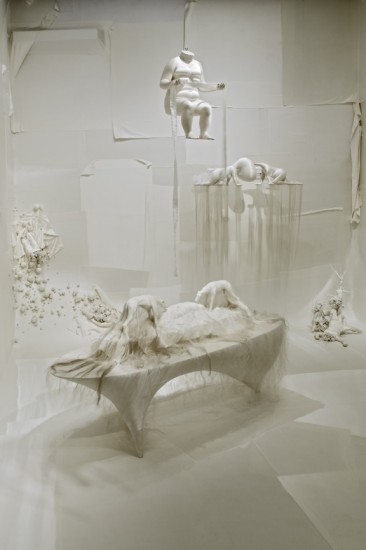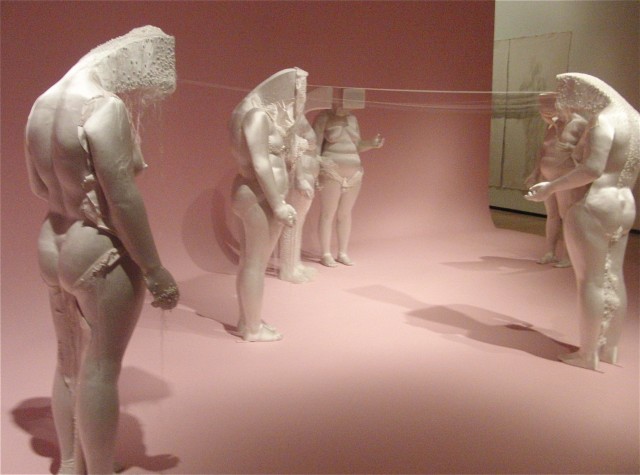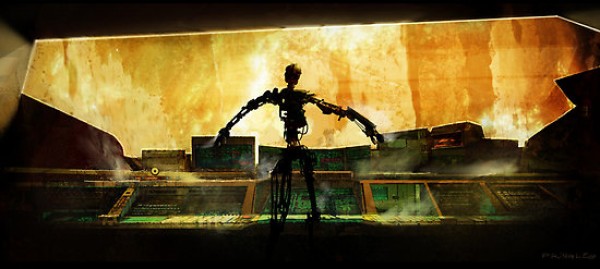Sporting one of the best beards in the business, the Reverend J. Peyton has been leading his trio, the Reverend Peyton’s Big Damn Band, through a rollicking brand of foot-stomping country blues for the last decade. On such albums as The Pork n’ Beans Collection, Big Damn Nation, The Whole Fam Damnily, and The Wages, Peyton, a real-life Kentucky Colonel, evokes such heroes as Charley Patton, B.B. King, and Jimi Hendrix. On the Indiana-based group’s latest record, Between the Ditches (SideOneDummy, August 2012), guitarist Peyton, his wife, “Washboard” Breezy Peyton, and drummer Aaron “Cuz” Persinger, whose kit includes a five-gallon bucket, take listeners on a thrilling journey through the back roads of America, proclaiming on the opener, “Devils Look Like Angels,” that “the devil don’t live / down in hell / the devil’s right here / doing very well / and it’s hard to tell / it’s hard to tell / when the devils look like angels / and angels look like hell.” Peyton went through hell himself when he was told as a teenager that he would never be able to properly use his left hand again on the six-string, but he proved the doctors wrong, and he continues to defy belief on Between the Ditches. “On this record, people are gonna think that there’s two guitars on it, and there’s not,” he explained at the album release show at Indy CD and Vinyl in August. “I promise, I swear, there’s no iPod, there’s no computer, there’s no loop pedal, there’s no guy hiding behind somewhere. It is all me, all right? My thumb plays bass, just like this. While my thumb’s playing bass, my fingers play the lead. Simple as that.” On the new disc, the group tears it up on such songs as “Big Blue Chevy ’72,” “Shake ’em Off Like Fleas,” “Brokedown Everywhere,” and “Something for Nothing,” creating a big yet intimate sound that just plain kicks ass. Known for their exuberant live shows where just about anything can happen, Reverend Peyton’s Big Damn Band will be at Mercury Lounge on December 9 with Johnnie Lee Jordan and the Boys and Rosco Bandana. “I have felt a lot of love from our fans lately,” the rev. recently wrote on his blog, “and I just want to say that I promise to always bring you real, handmade, from the heart, organic music in return.” That’s a lot better deal than one with the devil.
Yearly Archives: 2012
A CHRISTMAS STORY: THE MUSICAL
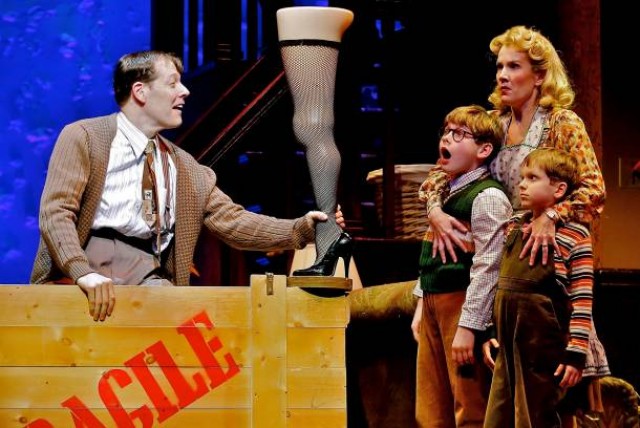
The Old Man (John Bolton) wins a major award in delightful Christmas musical (photo by Carol Rosegg)
Lunt-Fontanne Theatre
205 West 46th St. between Seventh & Eighth Aves.
Through December 30, $49-$159
www.achristmasstorythemusical.com
Bob Clark’s beloved holiday film, the 1983 family classic A Christmas Story, may now become a beloved classic Broadway musical as well with this sparkling Broadway adaptation. Joseph Robinette’s book and Benj Pasek and Justin Paul’s music and lyrics show deep respect for what makes Jean Shepherd’s tale about a young boy’s quest to find a highly coveted BB gun under the tree on December 25 so appealing. Under John Rando’s playful direction, the adult Shepherd (Dan Lauria) wanders the stage narrating his memories as nine-year-old Ralphie Parker (Johnny Rabe or Joe West), a generally good but occasional trouble-prone kid, dreams of receiving the best Christmas present ever. Meanwhile, his little brother, Randy (Zac Ballard), can’t move his arms in his winter coat; their mother (Erin Dilly) sweetly cares for Ralphie when she’s not washing his mouth out with soap for unleashing a dirty word; and their father (John Bolton, whose loose-limbed movement channels Dick Van Dyke), known as the Old Man, gripes and grumbles as he battles the neighbor’s dogs (played by real hounds), manhandles the furnace, and prepares to devour the Christmas turkey. As in Monty Python’s Spamalot, the vignettes in A Christmas Story: The Musical have become familiar favorites, and audiences will start smiling and laughing as many scenes open. The song titles alone let you know what you’re in for: “A Major Award,” “Sticky Situation,” “You’ll Shoot Your Eye Out,” and “Up on Santa’s Lap,” fancifully re-created by choreographer Warren Carlyle and set designer Walt Spangler.

Santa (Eddie Korbich) and his elves frighten young Ralphie (Johnny Rabe) in A CHRISTMAS STORY (photo by Carol Rosegg)
There are several bumps along the way — a few of the production numbers, including “Ralphie to the Rescue!,” are choppy and feel unfinished — but those minor quibbles can be forgiven, overshadowed by the sheer delight of “A Major Award,” in which the Old Man celebrates winning a lurid leg lamp in a crossword puzzle competition; the marvelous flat tire scene; and the splendid depiction of the fantasy/nightmare kids experience when visiting the local department-store Santa (Eddie Korbich). Lauria, who recently starred as legendary Green Bay Packers coach Vince Lombardi on Broadway and is most well known as the father in The Wonder Years — a character who shares much in common with the Old Man — is wonderful as Shepherd, reliving some of his seminal childhood remembrances in 1930s Indiana in a way that resonates with everyone. A Christmas Story: The Musical works because at its core, it’s a universal tale of growing up, of family, of being allowed to make mistakes while learning about the world around you, understanding that life is not as fra-gee-lay as so many other holiday books and movies would lead you to believe. Here’s hoping it shows up under the big Broadway Christmas tree for many a season to come.
LIN TIANMIAO: BADGES / BOUND UNBOUND
CHINA CLOSE UP: BOUND UNBOUND
Asia Society
725 Park Ave. at 70th St.
Tuesday – Sunday through January 27, $10 (free Friday 6:00 – 9:00)
212-288-6400
www.asiasociety.org
BADGES
Galerie Lelong
528 West 26th St. between Tenth & Eleventh Aves.
Tuesday – Saturday through December 15
212-315-0470
www.galerielelong.com
One of the foremost Chinese artists, Lin Tianmiao has been exploring the nature of gender through challenging sculpture, photographs, video, and installation for nearly twenty years, focusing particularly on incorporating what is considered “women’s work” and the role of the mother in her thought-provoking pieces, as seen in two current exhibits in Manhattan. At Asia Society (through January 27), “Bound Unbound: Lin Tianmiao” fills two floors and three galleries with several of Lin’s most intriguing installations. The earliest is her 1995 work “Proliferation of Thread Winding,” an eerie bed with twenty thousand steel needles tied to raw cotton thread that develops into small balls on the floor; a video monitor depicting the act of creating the balls serves as a pillow. It’s a terrific introduction to Lin’s multidisciplinary oeuvre: At first it looks like an extravagant marriage bed, then ends up being a statement on female domestic labor (melding both work and childbirth). Similarly, 1997’s “Bound and Unbound” features dozens of household items wrapped in thread while a film projection shows thread being cut. In “Chatting,” a group of six naked women, all based on Lin’s own body, stand on a pink platform, their box-shaped heads cast downward sadly, connected by thin wires that vibrate as a soundtrack of them talking can barely be heard. Nearby is “Endless,” a trio of three shriveled old men in pink who look so fragile that a mere breath could knock them over.
Although Lin, who spent eight years in New York City with her artist husband, Wang GongXin, before returning to Beijing in 1995, prefers not to be considered a feminist artist, the history and power of gender is central to her work. In “Sewing,” she has wrapped a sewing machine in white cotton thread and projects onto it a video of the act of sewing. In its own walk-in white room, “Mother’s!!!” consists of multiple headless female figures, both children and adults. In 2009, Lin made a major shift following the death of her mother, wrapping synthetic skulls and bones and placing them on exuberantly colored canvases and combining them with tools, giving them such titles as “All the Same” and “More or Less the Same,” inherently invoking that there is no difference between men, women, and children under the skin and noting that death awaits us all. Yet the works are not depressing nor morbid. “I believe that the bone is the only perfect object left in the world,” Lin says in the exhibition catalog. On December 7, Asia Society will host a free holiday celebration from 6:00 to 9:00 with guided tours of “Bound Unbound,” live jazz from pianist A. J. Khaw, trumpeter Jean Caze, and bassist Jon Price, a tea tasting and demonstration, store discounts, and more.
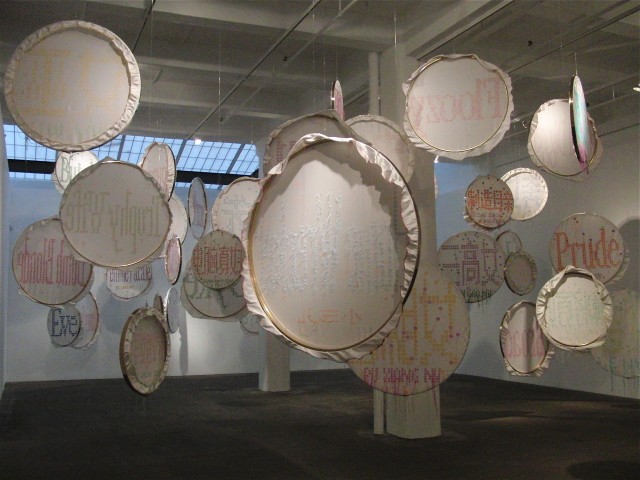
Lin Tianmiao, “Badges,” white silk, colored silk thread, painted stainless steel embroidery frame, sound component, 2011-12 (photo by twi-ny/mdr)
At Galerie Lelong through December 15, “Badges” features sixty white circles dangling from the ceiling, each bearing an embroidered slang word referring to women. Meanwhile, a robotic voice pronounces each one in an endless stream as the works twist around, making the text hard to read. Ranging in size from a diameter of 31.5 to 47.2 inches and in both English and Chinese, they display such stereotyped terms as “Dyke,” “Floozy,” “Tramp,” “Ho,” “Soccer Mom,” “Trophy Wife,” “Slut,” “Dumb Blonde,” “Home Wrecker,” and “Bimbo.” (Some of the Chinese phrases translate as “a woman who sleeps around,” “a woman who is unattractive both physically and in terms of personality,” “a well-educated woman with a high income and other highly sought after qualities but who has been unable to find a husband,” and “a woman who spends one third of her salary on her phone bill because she enjoys talking on the phone so much.”) Process, form, function, and gender all come together in a compelling display that deserves extended time to marvel in its complex simplicity. The exhibit also includes several of Lin’s more recent “Same” canvases, made of striking green, pink, and yellow with frames featuring wrapped bones. Seen together, “Bound Unbound” and “Badges” establish Lin as a major contemporary artist with fascinating ideas on the role of women in modern society.
VIDEO OF THE DAY: “KIN” BY 8MM
Judging by the lyrics on 8MM’s second full-length album, Between the Devil and Two Black Hearts (ChelseaGirl, September 2012), it might not be obvious that the band is led by husband Sean Beavan and wife Juliette Beavan, who actually appear to be a very happy couple. “You’re the devil and you’re killing me,” Juliette sings on the title track. “I breathe you in and you just bleed me out,” she cries on “Kin,” adding, “Every love’s a scar,” on “Around the Sun.” Formed in 2004 in California, 8MM was initially considered a trip-hop industrial group, but they have burst out of any confining mold on the new disc, from the Fleetwood Mac–esque title song and the hard-rockin’, anthemic “Kin” and “Around the Sun” to the bluesy “The Weight of You” and the country ballad “Everyone Says,” evoking such forebears as Aimee Mann, Fleetwood Mac, PJ Harvey, and Hank Williams along the way. Juliette, a Stop Staring! celebrity model, and Sean, a longtime producer of such powerhouses as Nine Inch Nails, Marilyn Manson, and Guns N’ Roses, exchange verses and harmonize together more than on their previous releases, going off in myriad directions and absolutely exploding on the hot, sexy “The One,” which ends in an orgiastic frenzy. 8MM, which also includes drummer Jon Nicholson, will be at Pianos on December 7 at 11:00 with Emily & the Complexes, Sophie et la Femme, the Henry Millers, the Middle Eight, and Wolff & Tuba.
HAPPINESS IS . . . REAR WINDOW
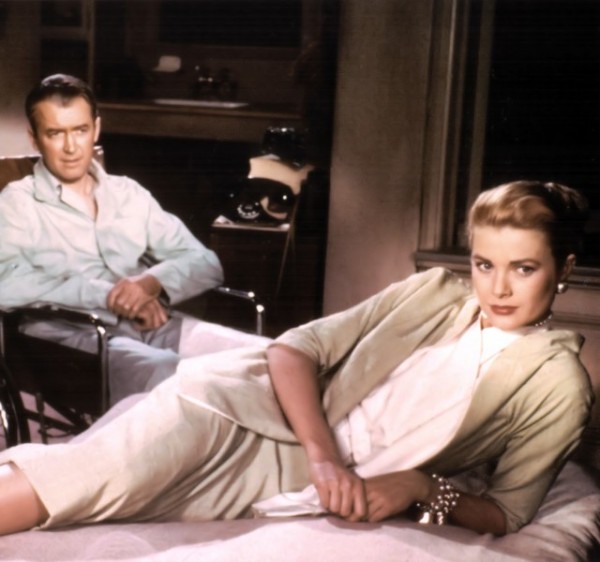
Jimmy Stewart and Grace Kelly might have just stumbled into the middle of a murder mystery in Hitchcock classic
CABARET CINEMA: REAR WINDOW (Alfred Hitchcock, 1954)
Rubin Museum of Art
150 West 17th St. at Seventh Ave.
Friday, December 7, free with $7 bar minimum, 9:30
212-620-5000
www.rmanyc.org
 There’s a reason why Alfred Hitchcock’s Rear Window keeps popping up all over town, at such venues as BAM, the IFC Center, and the Guggenheim Museum: Watching it makes people happy. One of the Master of Suspense’s best films, it’s an unforgettable voyeuristic thriller starring James Stewart as temporarily wheelchair-bound photojournalist L. B. Jeffries and Grace Kelly as his society-girl friend (and extremely well dressed) Lisa Carol Fremont. Bored out of his mind, Jeffries grabs a pair of binoculars and starts spying on the apartments across the courtyard from him, each one its own television show, including a musical comedy, a lonely romance, an exercise program, and, most ominously, perhaps a murder mystery. Ever the reporter, Jeffries decides to go after the possible killer, Lars Thorwald (Raymond Burr), and he’ll risk his life — and Lisa’s — to find out the truth. Sensational from start to finish, Rear Window works on so many levels, you’ll discover something new every time you watch it. Rear Window is screening on December 7, introduced by Russian-American documentary and fine art photographer Lena Herzog, as part of the Rubin Museum Cabaret Cinema series “Happiness is . . .,” held in conjunction with the larger Rubin Museum program “Happy Talk.” The series continues December 14 with the cheerful George Cukor classic Camille and December 21 with Gene Kelly having a blast in Vincente Minnelli’s An American in Paris before concluding December 28 with Roman Polanski’s not-quite-romantic-comedy Chinatown.
There’s a reason why Alfred Hitchcock’s Rear Window keeps popping up all over town, at such venues as BAM, the IFC Center, and the Guggenheim Museum: Watching it makes people happy. One of the Master of Suspense’s best films, it’s an unforgettable voyeuristic thriller starring James Stewart as temporarily wheelchair-bound photojournalist L. B. Jeffries and Grace Kelly as his society-girl friend (and extremely well dressed) Lisa Carol Fremont. Bored out of his mind, Jeffries grabs a pair of binoculars and starts spying on the apartments across the courtyard from him, each one its own television show, including a musical comedy, a lonely romance, an exercise program, and, most ominously, perhaps a murder mystery. Ever the reporter, Jeffries decides to go after the possible killer, Lars Thorwald (Raymond Burr), and he’ll risk his life — and Lisa’s — to find out the truth. Sensational from start to finish, Rear Window works on so many levels, you’ll discover something new every time you watch it. Rear Window is screening on December 7, introduced by Russian-American documentary and fine art photographer Lena Herzog, as part of the Rubin Museum Cabaret Cinema series “Happiness is . . .,” held in conjunction with the larger Rubin Museum program “Happy Talk.” The series continues December 14 with the cheerful George Cukor classic Camille and December 21 with Gene Kelly having a blast in Vincente Minnelli’s An American in Paris before concluding December 28 with Roman Polanski’s not-quite-romantic-comedy Chinatown.
JEAN-LOUIS TRINTIGNANT: THE CONFORMIST
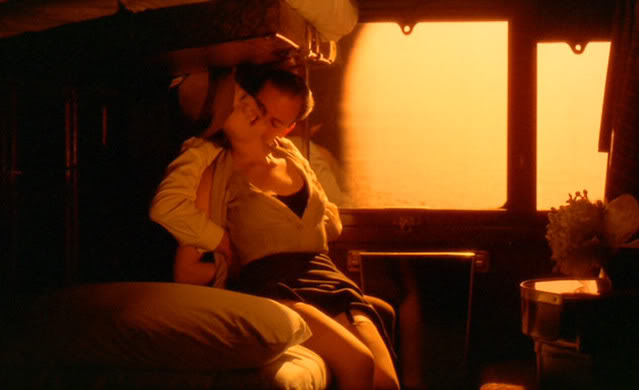
Jean-Louis Trintignant tries to find his place in the world in Bernardo Bertolucci’s lush masterpiece, THE CONFORMIST
THE CONFORMIST (IL CONFORMISTA) (Bernardo Bertolucci, 1970)
Film Forum
209 West Houston St.
Friday, December 7, and Saturday, December 8
Series runs December 7-20
212-727-8110
www.filmforum.org
 Based on the novel by Alberto Moravia, Bernardo Bertolucci’s gorgeous masterpiece, The Conformist, is a political thriller about paranoia, pedophilia, and trying to find one’s place in a changing world. Jean-Louis Trintignant stars as Marcello Clerici, a troubled man who suffered childhood traumas and is now attempting to join the fascist secret police. To prove his dedication to the movement, he is ordered to assassinate one of his former professors, the radical Luca Quadri (Enzo Tarascio), who is living in France. He falls for Quadri’s much younger wife, Anna (Dominique Sanda), who takes an intriguing liking to Clerici’s wife, Giulia (Stefania Sandrelli), while Manganiello (Gastone Moschin) keeps a close watch on him, making sure he will carry out his assignment. The Conformist, made just after The Spider’s Stratagem and followed by Last Tango in Paris, captures one man’s desperate need to belong, to become a part of Mussolini’s fascist society and feel normal at the expense of his real inner feelings and beliefs. An atheist, he goes to church to confess because Giulia demands it. A bureaucrat, he is not a cold-blooded killer, but he will murder a part of his past in order to be accepted by the fascists (as well as Bertolucci’s own past, as he makes a sly reference to his former mentor, Jean-Luc Godard, by using the French auteur’s phone number and address for Quadri’s). Production designer Ferdinando Scarfiotti and cinematographer Vittorio Storaro bathe the film in lush Art Deco colors as Bertolucci moves the story, told in flashbacks, through a series of set pieces that include an erotic dance by Anna and Giulia, a Kafkaesque visit to a government ministry, and a stunning use of black and white and light and shadow as Marcello and Giulia discuss their impending marriage. The Conformist is a multilayered psychological examination of a complex figure living in complex times, as much about the 1930s as the 1970s, as the youth of the Western world sought personal, political, and sexual freedom. The Conformist kicks off Film Forum’s two-week tribute to Trintignant, which also includes such double features as Krzysztof Kieslowski’s Three Colors: Red and François Truffaut’s Confidentially Yours, Claude Lelouch’s A Man and a Woman and Eric Rohmer’s My Night at Maud’s, and Jacques Deray’s The Outside Man and René Clement’s And Hope to Die in addition to Dino Risi’s Il Sorpasso, Sergio Corbucci’s The Great Silence, Costa-Gavras’s Z, and others, leading up to the theatrical release of Trintignant’s latest, Michael Haneke’s remarkable Palme d’Or winner Amour, which once again displays the actor’s unique range and sensitivity in an unforgettable performance that is likely to finally make him much better known in the United States, at the tender age of eighty-two.
Based on the novel by Alberto Moravia, Bernardo Bertolucci’s gorgeous masterpiece, The Conformist, is a political thriller about paranoia, pedophilia, and trying to find one’s place in a changing world. Jean-Louis Trintignant stars as Marcello Clerici, a troubled man who suffered childhood traumas and is now attempting to join the fascist secret police. To prove his dedication to the movement, he is ordered to assassinate one of his former professors, the radical Luca Quadri (Enzo Tarascio), who is living in France. He falls for Quadri’s much younger wife, Anna (Dominique Sanda), who takes an intriguing liking to Clerici’s wife, Giulia (Stefania Sandrelli), while Manganiello (Gastone Moschin) keeps a close watch on him, making sure he will carry out his assignment. The Conformist, made just after The Spider’s Stratagem and followed by Last Tango in Paris, captures one man’s desperate need to belong, to become a part of Mussolini’s fascist society and feel normal at the expense of his real inner feelings and beliefs. An atheist, he goes to church to confess because Giulia demands it. A bureaucrat, he is not a cold-blooded killer, but he will murder a part of his past in order to be accepted by the fascists (as well as Bertolucci’s own past, as he makes a sly reference to his former mentor, Jean-Luc Godard, by using the French auteur’s phone number and address for Quadri’s). Production designer Ferdinando Scarfiotti and cinematographer Vittorio Storaro bathe the film in lush Art Deco colors as Bertolucci moves the story, told in flashbacks, through a series of set pieces that include an erotic dance by Anna and Giulia, a Kafkaesque visit to a government ministry, and a stunning use of black and white and light and shadow as Marcello and Giulia discuss their impending marriage. The Conformist is a multilayered psychological examination of a complex figure living in complex times, as much about the 1930s as the 1970s, as the youth of the Western world sought personal, political, and sexual freedom. The Conformist kicks off Film Forum’s two-week tribute to Trintignant, which also includes such double features as Krzysztof Kieslowski’s Three Colors: Red and François Truffaut’s Confidentially Yours, Claude Lelouch’s A Man and a Woman and Eric Rohmer’s My Night at Maud’s, and Jacques Deray’s The Outside Man and René Clement’s And Hope to Die in addition to Dino Risi’s Il Sorpasso, Sergio Corbucci’s The Great Silence, Costa-Gavras’s Z, and others, leading up to the theatrical release of Trintignant’s latest, Michael Haneke’s remarkable Palme d’Or winner Amour, which once again displays the actor’s unique range and sensitivity in an unforgettable performance that is likely to finally make him much better known in the United States, at the tender age of eighty-two.
THE PHILIP K. DICK SCIENCE FICTION FILM FESTIVAL
IndieScreen
285 Kent Ave. at South Second St.
December 7-9, $5-$55
347-227-8030
www.thephilipkdickfilmfestival.com
www.indiescreen.us
During his short life, Philip Kindred Dick, who died in 1982 at the age of 53, wrote nearly 50 novels and more than 150 short stories in addition to nonfiction essays and books. The work of the science-fiction master has been turned into such major films as Blade Runner, Minority Report, A Scanner Darkly, The Adjustment Bureau, and Total Recall and has inspired countless others. The Philip K. Dick Film Festival, taking place in Brooklyn, Queens, and Manhattan December 7-9, celebrates Dick’s legacy with three days of features, shorts, animated flicks, and more either based directly on his writing or focusing on such favorite Dick themes as the changing nature of humanity in a world overrun by technology. The festivities get under way on Friday night at IndieScreen with John Alan Simon’s Radio Free Albemuth, which is based on the 1976 novel and includes a character named Philip K. Dick, played by Shea Wigham; Alanis Morissette also appears in the film. The screening will be followed by a Q&A with Simon. Next up is Eli Sasich’s dazzling short, Henri, in which a robot is brought to life as disaster looms; yes, those two actors are indeed Margot Kidder and Keir Dullea. Among Saturday’s special events are the panel discussions “H. P. Lovecraft and Philip K. Dick,” “Intruders Amongst Us — ETs and UFOs,” and “Is Science Fiction the Science of the Future?” in addition to such films as Odokuro, In Aeternum, First Winter, and Ninjas vs Monsters. Sunday’s selections run the gamut from Demonen — Inviting the Demon and Blood for Irina to Transmission and Caterwaul, a charming little examination of a lonely old man (George Murdock from The Twilight Zone, Barney Miller, and myriad other television series; he passed away this past April at the age of eighty-one) who finds an odd companion in a very different kind of lobster. There will also be a shorts program on Friday at the Instituto Cervantes and screenings on Saturday at Singularity and Company in DUMBO, the Producers Club, and the Spectacle Theater. And on Sunday, the Museum of the Moving Image will host the all-star panel “The Outsider in Science Fiction — African American and Latino Perspectives” with Walter Mosley, Samuel R. Delany, Alex Rivera, Lawrence Oliver Cheery, Lola Salvador, and Carlos Molinero, moderated by Warrington Hudlin. There are various options for buying tickets, from paying $5 per short to $10 per feature to $15 per day or $45 for all three days, with prices going up the day of the event.
